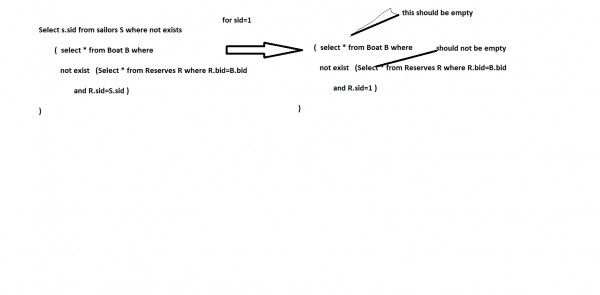Lets say we have three sets
1.Sailors
2.Boats
3.Reservation
1.IN/NOT IN--
SELECT S.SNAME FROM SAILORS S WHERE S.SID IN
(SELECT R.SID FROM RESERVES R WHERE R.BID =103)
This query works as follow
1.Take all the suppliers id from reservation table who reserve boat number 103.----->this is set S
2.Now take every sailor row from sailor table such that, that sid is in set S and print the sailor names of such sailors.
So,this query prints "sailor names of all the sailors which reserve boat number 103"
Now take case when inner query result is empty or no supplier book boat number 103.
In that case ,there will be no row in inner table ,hence we will get empty result.
So,In is just a "equal condition",which check every row of outer table with every row of inner table.
And ,Not in is "Not equal to condition".
Lets take one another example
SELECT S.SNAME FROM SAILORS S WHERE S.SID NOT IN
( (SELECT R.SID FROM RESERVES R WHERE R.BID
NOT IN
(SELECT B.SID FROM BOATS B WHERE B.color ="RED") )

2.Operator ANY/ALL
Select s.rating from Sailor S where S.rating >=ALL
(Select S.rating From Sailor S)
This query return highest rating from the sailor table.
For each outer table row it compare it with every row of inner table with given operator.
If operator result true in every case then it print outer table row.
ALL-true when set is empty-same as For all quantifier
ANY-false when set is empty-same as there exist quantifier
3.Exists/Not Exists
This operator work in corelated nested queries.
Exist-true when there is at least one row in inner query result---true when inner query result is non-empty
Not exist -true when there is no row in inner table-----true when inner query result is empty
1.Select s.sid from sailors S where exists
(Select * from Reserves R where R.bid=007
and R.sid=S.sid )
2.
1.Select s.sid from sailors S where not exists
(Select * from Reserves R where R.bid=007
and R.sid=S.sid )
for above query inner query result should be empty.
And inner query result is empty when selected sid from outer query doesn't reserve boat 007.
So,result is all those sid which didn't reserve any boat with boat number 007.
3.
Select s.sid from sailors S where not exists
( select * from Boat B where
not exist (Select * from Reserves R where R.bid=B.bid
and R.sid=S.sid )
)

Hence this query select all those suppliers id which have at least one boat.